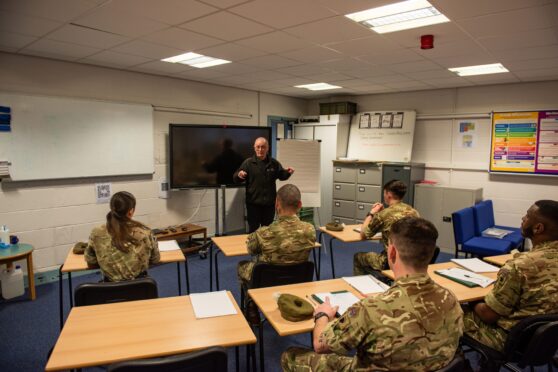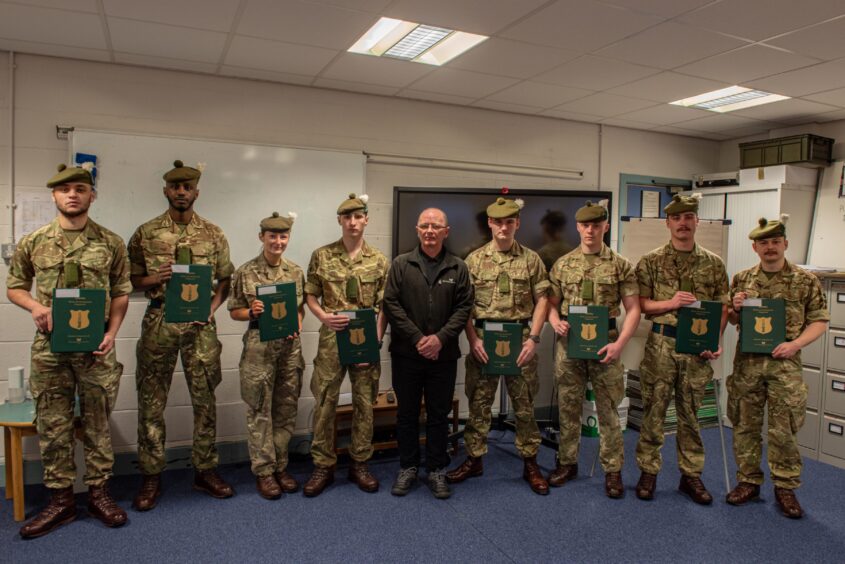
According to military wisdom, sweat saves blood and blood saves lives. Brains, however, can save both.
Scotland’s only infantry regiment is hitting the books in an effort to help them tackle life-threatening situations.
Soldier-turned-educator Alan Laidlaw is helping troops in The Royal Regiment of Scotland to attain the academic qualifications they were unable to achieve in a traditional school setting.
Not only does it set them up for civilian life once they leave the army, the skills could mean the difference between life and death, according to Alan.
“If you’re given a 24-hour ration pack at 8am, when are you going to expect your next ration pack? What if you have 20 men and you’re out on a mission for five days?” says Alan, 59.
“If you’re tasked with digging a trench how much earth needs to be moved? How long will it take if 20 guys are doing it?
“You need to get it right, using solid maths. If you get it wrong, that could be bad for you and your soldiers. That’s where we help.”
While the Army is famed for accepting candidates with little education, modern soldiers are expected to achieve standards in basic maths and English to gain their army apprenticeship. Alan helps young soldiers achieve that, as well as qualifications to help them promote through the ranks.
Alan, who has dyslexia and left school at 16 before joining the army, recognises the challenges of educating soldiers wary of the classroom.
“A lot of these guys are coming in after having left school where they skived in class, didn’t attend school or, if they did, didn’t want to be there,” he said. “The first thing some of them say is, ‘this is like being back at school’.
“Well it’s not. You’re a soldier. You’ve got to take charge of your own education. That’s the first step in breaking down a barrier.
“If you can do that, you create a bond by finding out what they want to achieve, then you help them achieve it.
“I have to think, ‘what is their burden? What is stopping them from moving forward?’
“It’s not just about giving them skills, I want to find out where these young men and women want to go in life and assist them in getting there.”
‘Alan just made sure we got it.’
Fusilier Matthew Logie, 24, from Fife, has been a soldier for two-and-a-half years, who’s currently waiting to deploy. He gained maths qualifications thanks to Alan’s teaching.
“I didn’t really like school too much and although I picked up some qualifications, it wasn’t really for me,” he said. “I tried, but I wasn’t that good of a student, really. Whereas in the army it’s a job, but it’s also fun.
“Alan is a really laid back teacher but importantly I could tell he actually cared. In school I sometimes had teachers who just wanted to do the job and leave, and others who would sit with you and make sure you understood it. Alan didn’t get angry, he just made sure we got it.
“The things we learn are very practical, in the infantry we do something called ammo statements, where you work out what percentage of ammunition everyone in the squad has.
“Maths was a struggle for me when I was a student so when I eventually passed I felt real pride.”
Matthew now, thanks to his Army education, plans to study business once he leaves the military.
‘These soldiers are all over the world’
It’s not just Scottish soldiers in The Royal Regiment of Scotland; Alan also teaches men and women from the Commonwealth with varying levels of English abilities.
“We’ve got a lot of guys from Fiji or Jamaica or Saint Lucia whose home had English as a second language; they might have been a farmer all of their life who have never been to school,” he added.
“It’s about giving them an opportunity to improve. We start off with a lot of soldiers from scratch.
“But the hardest part of the job isn’t teaching soldiers, it’s getting them into the classroom. “These are busy people, doing tasks, driving around to different areas, they’re training and going abroad at short notice.
“But the good news is we can adapt; we’ve got a group who went to Estonia to deliver training, there’s trainers in Cyprus, they’re all over the world.”
“I’m going into my 10th year. I started in the army, had a career path elsewhere and came back. I started with the army and I’m finishing with it.
“I’m 60 now, so it’s nice when I’m coming to the end of the cycle of my career path to teach these young soldiers who are starting out like I did.
“You don’t really get many pats on the back with this job. There was someone the other day who I first saw as a fresh-faced 17 year old, now it’s three years later and he’s filled out as a person and he’s more mature.
“I know he wouldn’t be where he is if it wasn’t for this system. That’s where I get my pat on the back.”

Enjoy the convenience of having The Sunday Post delivered as a digital ePaper straight to your smartphone, tablet or computer.
Subscribe for only £5.49 a month and enjoy all the benefits of the printed paper as a digital replica.
Subscribe © LCpl Martin Walker
© LCpl Martin Walker